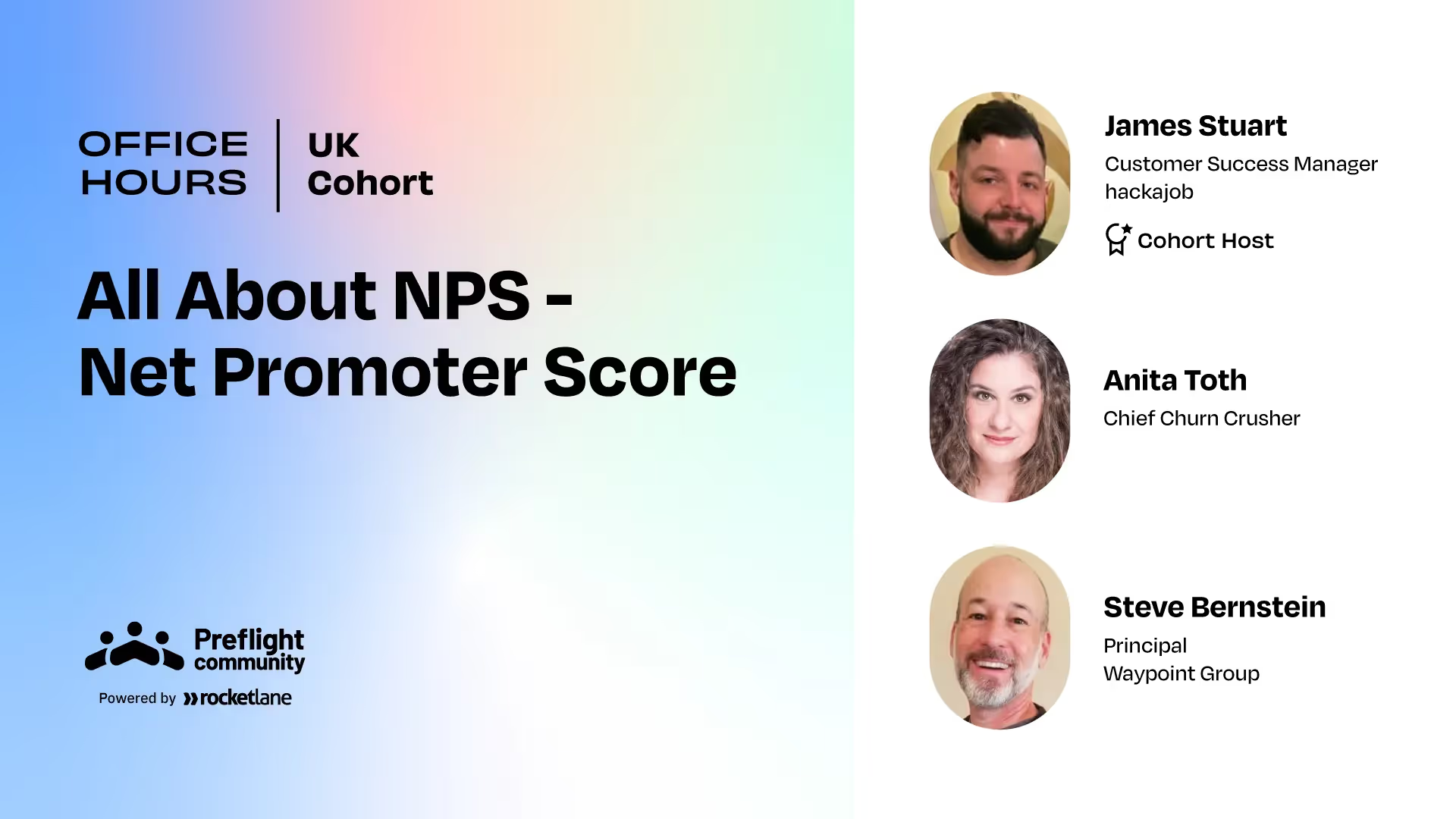In this session of Preflight UK’s Office Hours, James Stuart, CSM at hackajob spoke to Anita Toth, creator of Customer Insights 360, a B2B customer insight collection system, and Steve Bernstein, Co-founder and Principal Consultant, Waypoint Group on NPS for B2B customers.
Anita works with Chief Customer Officers and Customer Success leaders in B2B SaaS companies to help them retain customers and grow their retention revenues. With 20+ years of experience in academic research, Anita created Customer Insights 360 to help leaders find deep customer insights that reduce churn, increase retention, and grow NRR while providing a consistent customer experience. She also co-leads the Community Insights committee at Gain Grow Retain.
Steve founded Waypoint to tilt NPS to the complexities of B2B. He is also the author of Failure Sucks! (More for Your Customers, Than for You): A B2B Guide to Customer Success. Steve has over 20 years of experience in customer experience and has also developed new solutions for Satmetrix, creator of the Net Promoter System.
Waypoint’s TopBox is a B2B customer engagement solution that helps B2B companies accelerate revenue growth and positive word-of-mouth from their existing customers by amplifying and acting on customer insights to fuel stronger relationships.
The discussion focused on:
- Why NPS for B2B customers is a different ballgame
- The NPS system approach that B2B needs
- Best practices to make the most out of NPS
- Using the NPS to understand customers
Here are our top takeaways from the session.
You can watch the full recording here
Why B2B NPS needs a different approach and design
NPS was designed for B2C customers, and B2B has a significantly longer and more complex buying cycle. It typically involves multiple and diverse stakeholders such as financial decision-makers, project managers, and end-users. This means that the:
- Standard singular NPS question (asking customers how likely they are to recommend a product or service to others on a scale of 0-10) makes little sense in the B2B context
- CS teams need to look beyond a single question and focus on designing a system that draws from the NPS in its original form
- NPS needs to cater to the different personas in a customer account for it to be effective and useful
- CS teams and companies need to have a defined sampling and segmenting strategy in addition to tracking respondents longitudinally
In other words, NPS shouldn’t be a milestone or an item on a checklist; it should be a strategy that aims to tell a story.
Designing an effective and valuable B2B NPS system
In the B2B context, it makes more sense to use the NPS to understand if everyone in the account is receiving value with your product/service and using it as a way to course-correct.
The critical aspects of an effective NPS strategy include:
- Aligning on the objective of the NPS
- Asking persona-appropriate questions
- Closing the loop with the customer
Using the NPS system as a diagnostic tool for improvement and course-correction
Much like a check-in with a patient, an NPS system is a diagnostic exercise that shows the signs/symptoms of customer accounts. It needs to be followed up with root cause identification and remediation. Here are some key points to consider for each stage.
Diagnosis
The following three questions in your NPS questionnaire can help elicit helpful responses for diagnosis:
- What did you experience?
- What did you expect?
- Why did you expect it?
Investigation
Every NPS instance is an opportunity for you to identify four different types of accounts:
- Happy (with your product/service)
- Satisfied
- Unhappy
- Unresponsive
You need to recognize all four of them for the NPS exercise to be representative of customer sentiment and, therefore, valuable. When you fail to consider unresponsive customers as a category, you could effectively recognize a score/sentiment based on only a fraction of your customers.
NPS response rates are strong signals of churn. Critical feedback is a cry for help and, therefore, an excellent opportunity for course correction. Similarly, silent accounts are far more likely to churn. Speak to detractors to identify bottlenecks and pain points and reach out to passives to gauge what is happening.
Closing the loop
People like to feel heard and to know that they matter. Closing the loop and telling customers how you used the NPS is the biggest lever you can pull in your customer feedback approach.
This follow-up can be one-on-one, one-to-account, or one-to-many. For each account, make sure to aggregate feedback and create a success plan for the account. Use Quarterly Business Reviews to have an open dialogue on NPD findings or conduct further interviews.
Three mistakes to avoid in your NPS strategy
1. Not designing the NPS system per the customer lifecycle
Most companies resort to quarterly on annual email blasts for their NPS. This doesn’t work for two reasons:
- This approach doesn’t align with customers’ unique lifecycles and, therefore, could fail to represent customer sentiments accurately
- The volume of responses becomes overwhelming for CSMs to manage and use effectively
2. Asking the wrong questions
In addition to timing the NPS touchpoint correctly, customer-facing teams also need to know what to ask at which stage of the lifecycle.
For instance, at the end of onboarding, instead of asking the default NPS question (‘how likely would you be to recommend our product/service?’), ask, ‘How did we do on onboarding?’, ‘Did our onboarding process get you what you needed/where you needed to be/make you confident to use our product independently?’
3. Focusing on the wrong metric
When you use only a final score for the NPS system, you risk not getting an accurate picture of your customers’ sentiments across accounts. Instead, it might be sensible to focus on a more valuable and representative metric, such as the percentage of promoters.
Consider that you have three accounts of 1000 people each. Of these, let’s consider that only 300 people responded to your NPS survey. This means that only 300/3000, i.e., 10% of your customers are promoters in the true sense of the word.
Best practices to consider while designing a B2B NPS strategy
- Establish a clear WIIFM for the respondent: Tell your customers exactly how responding to your NPS will benefit them.
- Your customer accounts are like fruit salads. Don’t compare oranges and apples: Use segmentation effectively: Segment respondents within customer accounts (into decision-makers, end-users, administrators, etc.) and compare results for segments across different accounts.
- Words matter. Choose them wisely: Steer clear of phrases like ‘ Take our survey.’ Instead, say, ‘Take X minutes to assess your experience with us.’
- Outline expectations clearly: Mention upfront the time and effort the NPS exercise will take at their end. Ideally, a questionnaire should not take more than five minutes of the respondent’s time.
- Customize the questionnaire to ensure it respects the respondent’s time: Limit the questions by tailoring them to the persona of the respondent. For instance, right at the start of the survey, you could ask, ‘To ensure that this questionnaire makes the best use of your time, please select the sentence that describes how you work with us”. Use this input as part of branching logic to target them with the right question(s).
- Coordinate cross-functionally: Understand how and where the NPS fits within your company’s overall customer feedback collection. Coordinate with Product or Marketing to ensure no time or content overlaps/clashes.
- Design and brand your NPS initiative. Your NPS represents your approach to customer experience. Design it to make the best impression. This could involve:
- Naming the initiative (Waypoint calls their NPS system WOW (Waypoint On Waypoint)
- Communicating the cadence of NPS collection in advance
- Going beyond automated emails to have conversations about the need for feedback and how you will use it to benefit them
- Streamline and dashboard-ize NPS reporting: Set up an account view that allows you to share anonymized findings for each persona with the customer. This can help you:
- Draw attention to, and therefore, improve response rates
- Identify and share areas within the customer account that need attention/intervention
- Show customers how they fare in comparison with similar customers
If you want to learn more about Customer Onboarding, Implementation, and Professional Services in-depth, join the Preflight Community.






















.webp)
